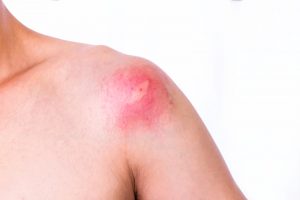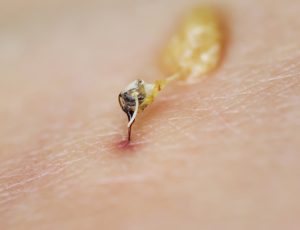How to Treat a Bee Sting
Ouch! That jab you just felt was an angry little flying insect with a stinger. Here's how to treat a bee sting.
You’re outside on a hot day, minding your own business as you rake around the shrubbery when, out of the blue, you feel the unmistakable jab of an angry bee’s stinger. If you’re lucky, it’s just one. Your first goal is to get the heck away from the scene of the crime. Bees live in colonies, so if one stings you, there may be more behind it. Once you’ve high-tailed it away from the danger area and made sure there’s no swarm following you, you can tend to the most important matter at hand: how to treat a bee sting.
First, understand that a bee sting involves the injection of a poisonous venom into your body, so there’ll be a reaction. If you’re allergic to bee venom—a reaction known as anaphylaxis—you could experience severe symptoms, including swelling in your mouth and/or throat, shortness of breath, hives, wheezing, nausea and/or vomiting, diarrhea, or chest pain. In extremely severe cases, a bee sting can be fatal (there are around 50 deaths attributed to bee stings in the U.S. every year). Those with a known allergic reaction should carry an epinephrine autoinjector and wear medical ID jewelry stating the allergy.
In most cases, though, a bee sting is an annoyance—albeit one that comes with pain—that you can treat without professional medical care.
How to Treat a Bee Sting

A honey bee’s sting can leave a painful welt. Icing it quickly can keep the swelling down.
As noted above, seek immediate medical care if you know you’re allergic to bee stings. Otherwise, here’s how to treat a bee sting to lessen its impact:
- Wash the site of the sting with soap and water.
- Remove the stinger using gauze wiped one the area or by scraping a fingernail over the area. Don’t use tweezers, the CDC says, and don’t try to “squeeze” the stinger out, because you’ll also be squeezing into your body more venom from the attached venom sac.
- Apply ice to reduce swelling. As Ronald Lentz, MD, medical director of the Block Island Medical Center in Rhode Island, told Yankee Magazine via its website, New England Today: “Once you’ve made sure the stinger is out and the area is clean, put an ice cube directly on the sting for a few minutes.”
- Avoid the temptation to scratch the sting area; it may increase swelling, itching, and risk of infection.
- Consider using an antibiotic ointment (such as Neosporin) on the sting site. Also, diphenhydramine, an antihistamine found in such medications as Benadryl, may be taken to relieve the itching of bee stings (not to mention other insect bites, sunburn, poison ivy, and poison oak). Ibuprofen (Motrin) or acetaminophen (Tylenol) also may help with pain relief.
Even with prompt treatment, the site of a bee sting may remain swollen and painful for two or three days after the event.

The poison in the sac attached to a honey bee’s abandoned stinger can continue to release venom two to three minutes after detachment.
Bees and Venom
When a bee stings, the stinger itself—with attached venom sac—typically stays behind in your skin, inflicting a extra venom and pain. In fact, a detached honey bee venom sac may continue pumping out its contents for two to three minutes, so a quick removal of the stinger will save some pain. (The stinger will look like a small black dot at the sting site.)
Honey bees have barbed stingers that, after penetrating a mammal’s thick skin, will detach and remain in the victim. Yes, the result is death for the honeybee. Because a honey bee cannot pull out its barbed stinger, the appendage tears away from its body, leaving with it abdominal muscle and nerves and tissue. Black wasps, hornets and certain other types of bees don’t have barbed stingers, and thus can safely extract them—and sting again (and again and again!).
BEE FACTS
Honey bees have “six legs, two compound eyes (one on each side of the head) made up of thousands of tiny lenses, three simple eyes on the top of the head, two pairs of wings, a nectar pouch, and a stomach,” according to benefits-of-honey.com. A honey bee’s wings stroke at the amazing clip of 200 beats per second—the reason for the distinctive buzz.
And what about the venom we get from a honey bee’s sting? Biologist Matan Shelomi, Assistant Professor of Entomology at National Taiwan University, offers a descriptive explanation at Quora: “This venom is a nasty cocktail of poisons: chemicals to break down the cell membrane and cause pain, anti-inflammatories to stop blood flow that would otherwise clear out the toxins, histamines that give you the allergic reaction symptoms, and even pheromones that signal to any bees in the vicinity, ‘We are at war! Come, sister, and sting here too!'”
Only female honey bees, by the way, sting us.
An Ounce of Prevention
How to treat a bee sting? Prevention is the best approach. So during spring and summer, when they’re most active, take precautions. When you’re working or playing outside, wear light-colored, smooth-finished clothing that covers as much of your body as possible, the Centers for Disease Control & Prevention advises. Avoid perfumed soaps, shampoos, and deodorants as well as perfume and cologne. The CDC also advises, “Avoid bananas and banana-scented toiletries.”
If a single bee is flying around, stay calm; swatting at it may cause aggression. If several bees seem to be forming a swarm near or around you, get away from the area as quickly as possibly and without antagonizing the insects.
Remember that loud, motorized equipment (lawnmowers and weed trimmers, for examples) can provoke bees. If you’re dining or camping outdoors, food will attract bees, so keep the area clean and dispose of garbage quickly.
SOURCES & RESOURCES
For more information about bee (and wasp) stings, consult:
American Academy of Allergy, Asthma, and Immunology
555 East Wells St., Suite 1100, Milwaukee, WI 53202-3823
Phone: 800-822-2762
Centers for Disease Control and Prevention
1600 Clifton Road, Atlanta, GA 30329-4027
Phone: 800-CDC-INFO (800-232-4636)
National Institute of Allergy and Infectious Diseases
6610 Rockledge Drive, MSC 6612, Bethesda, MD 20892-6612
Planet Bee Foundation
3035 25th Ave., San Francisco, CA 94142
Name That Stinging Insect!
When it comes to flying insects capable of inflicting painful stings, there’s often confusion around which is which. We’ll let the American Academy of Allergy, Asthma, & Immunology clear it up for you:
- Honeybees and bumble bees are non-aggressive and will sting only when provoked. However, Africanized honeybees (a.k.a. “killer bees”) found in the southwestern U.S. are more aggressive and may sting in swarms. Domesticated honeybees live in man-made hives, while wild honeybees live in colonies or “honeycombs” in hollow trees or cavities of buildings.
- Yellow jackets‘ nests are made of a paper-maché material and are usually located underground, but can sometimes be found in the walls of frame buildings, cracks in masonry or woodpiles.
- Paper wasps‘ nests are usually made of a paper-like material that forms a circular comb of cells which opens downward. The nests are often located under eaves, behind shutters, or in shrubs or woodpiles.
- Hornets are usually larger than yellow jackets. Their nests are gray or brown, football-shaped and made of a paper material similar to that of yellow jackets’ nests. Hornets’ nests are usually found high above ground on branches of trees, in shrubbery, on gables or in tree hollows.
- Fire ants build nests of dirt in the ground that may be quite tall (18 inches) in the right kinds of soil.
BEES BE GONE?
Legions of us will run when we encounter a bee, but some do the opposite: They nurture bees. In fact, there are between 115,000 and 125,000 beekeepers in the U.S., according to the National Honey Board. Around 2,000 of those are commercial honey producers. The majority of beekeepers are hobbyists (fewer than 25 hives).
However, studies have shown a decline in the population of bees in the U.S. in recent decades. A Bloomberg report in May 2018 noted, “U.S. beekeepers said 40 percent of their hives, also called colonies, died unexpectedly during the year that ended March 31, according to a survey released Wednesday by researchers from Auburn University and the University of Maryland. That’s up from 33 percent a year earlier.” Climate change, habitat loss, and pesticides are among the top factors to blame.
What can you do? How about starting your own bee hive? Countryside Network offers these posts on how to get into it:


 Vestibular Migraine Diet
Vestibular Migraine Diet  Bone Spurs on the Spine
Bone Spurs on the Spine  Knee Injections for Osteoarthritis Pain Relief
Knee Injections for Osteoarthritis Pain Relief 
How to treat a bee sting? First step: Get that stinger (and its attached venom sac) out of your skin.
© Palex66 | Dreamstime.com